Contents
- 1. Om mantra (Omkar)
- 2. Gayatri mantra and Om mantra
- 3. Mrutyunjay mantra and Om mantra
- 4. Navarnav (nine letter) mantra and Om mantra
- 5. Shri Ganesh mantra and Om mantra
- 6. Vedic mantras and Om mantra
- 7. Mantras recommended by some sages
- 8. Mantras associated with various sects
1. Om mantra (Omkar)
This is written as ‘Om (ॐ)’ and is considered as the sacred vowel. Not only is Om mantra a mahamantra with a single letter but is also labelled as the monosyllabic Brahman in the Shrimadbhagvadgita. The sage of this mantra is Parabrahman, the deity Parmatma and the rhythm (chanda) Gayatri. The mahamantras from the Vedas, Upanishads, etc. and also the efficacious (siddha) mantras and Names denoting The Lord are the varied forms of this Omkar. When chanting every mantra it is essential to start it with the Om mantra or also known as Omkar.
‘The scriptures describe the pranav, that is, Om mantra as the “monarch of mantras”. It is considered as the symbol or representation of the individual soul. Om mantra or Omkar is the main Name of The Supreme Brahman (Parabrahman). Since acquisition of knowledge about it means realisation of Parabrahman, worshipping it is the same as worshipping The Supreme God. The famous quote from the Upanishads ‘अयमात्मा ब्रह्म’ means ‘This soul is Brahman’. Once one realises through meditation that the entire universe is composed of Om mantra or Omkar and develops conviction that every object in the universe and every individual soul itself is Brahman, the realisation of Brahman as the soul, is achieved and finally one attains Self-realisation of the unmanifest (nirgun) Brahman in the form of “I am Brahman (अहं ब्रह्मास्मि)”.
Mr. Shantaram Athavale has explained the process of this mode of worship as follows: In the worship of Om mantra or Omkar, the embodied soul (jiva) should harbour the emotion that the letter ‘a’ in Omkar represents the dissolution of the physical body in The Absolute Being’s (Virat Purush’s) body. The ‘u’ means the dissolution of one’s subtle body in the subtle body of the universe that is, the hiranyagarbha and the ‘m’ means the entry of one’s causal body into the great illusory body (mayadeha) of the universe. The dot shaped like the moon (chandrabindu) indicates that one’s supracausal body (mahakaran deha) has dissolved in the all witnessing Lord, that is the basic (mul) Prakruti.’ (1)
The table below clarifies the meaning of the four parts of Omkar – a, u, m and half matra.
| a | u | m | The half mantra | |
| 1. The site of operation |
Waking state (jagruti) |
Dream state (svapna) |
Deep sleep state (sushupti) |
Superconscious state (turya) |
| 2. The name of the soul performing a specific action |
Vaishvanar | Taijas | Pradnya | Turiya |
| 3. Whose worship is being performed |
Then visible universe |
The invisible or subtle universe |
Layayoga (Dissolution of the ego) |
Non-duality (advait) |
2. Gayatri mantra and the Om mantra
- A. ॐ तत् सवितु: वरेण्यं भर्गो देवस्य धीमहि ।
धियो यो न: प्रचोदयात् ।
Variation:
ॐ भूर्भुव: स्व: तत् सवितु: वरेण्यं भर्गो देवस्य धीमहि ।
धियो यो न: प्रचोदयात् ।The meaning: We are meditating on the supreme brilliance of the Savita (Sun) deity of the three worlds, the earth, the nether world and heaven (bhu, bhuva and svarga). Hence may our intellect become sharp.
- B. The three step (tripad) Gayatri: In this, Om mantra appears thrice as follows:
ॐ भूर्भुव: स्व: ।
ॐ तत् सवितु: वरेण्यं भर्गो देवस्य धीमहि ।
ॐ धियो यो न: प्रचोदयात् ।In the three step Gayatri, when the first step is chanted with inspiration the second with breath holding and the third with expiration, pranayam in the proportion of 1:4:2 occurs with inspiration (purak), breath holding (kumbhak) and expiration (rechak).
- C. The four step (chatushpad) Gayatri: Besides the three Oms of the three step Gayatri, the fourth Om is suffixed to ‘prachodayat (प्रचोदयात्)’. Due to this Om, breath holding (kumbhak) also occurs after expiration (rechak).
- D. Spontaneous chanting of Gayatri (ajapa Gayatri): Concentrating on the sound so’(saha) during inspiration and ham during expiration (so’ham) is called spontaneous (ajapa) Gayatri or spontaneous chanting (ajapajapa).
- E. Gayatri mantras of different deities: Various deities have their respective Gayatri mantras, for instance the deities Krushna, Rama, Sarasvati. Information about the corresponding mantra is given in the context of the respective deity.
Saints recommend the appropriate Gayatri japa according to one’s requirement.
3. Mrutyunjay mantra and Om mantra
ॐ त्र्यंबकं यजामहे सुगंधिं पुष्टि वर्धनम् ।
उर्वारुकमिव बन्धनात् मृत्योर्मुक्षीय माऽमृतात् ।
The meaning: We worship the three eyed Lord Shiva. May the fragrance of our energy and fame spread far and wide. Just as a dried cucumber gradually falls off from its stalk so also may our binding to death disappear unknowingly. Likewise may we be liberated from the cycle of birth and death and may we attain the Final Liberation (Moksha).
4. Navarnav (nine letter) mantra and Om mantra
Nav (नव) refers to nine and arnav (अर्णव) to letters. In the mantra ‘Om aim rhim klim Chamundayai vichche (ॐ ऐं र्हीं क्लीं चामुण्डायै विच्चे ।)’ there are nine letters excluding Om mantra, which is the representation of the unmanifest (nirgun). The nine letters and their meanings are as follows:
| aim | : Kalika or Mahakali |
| rhim | : Lakshmi or Mahalakshmi |
| klim | : Sarasvati or Mahasarasvati |
| cha mu nda yai | : To Chamunda (the female deity) |
| vi chche | : I offer obeisance |
The meaning: I offer obeisance to You O deity Chamunda who possesses the three qualities of Mahakali, Mahalakshmi and Mahasarasvati.
5. Shri Ganesh mantra and Om mantra
‘Om ga-aum Ganapataye namaha (ॐ गं गणपतये नम: ।).’ In this mantra Om is the pranav (symbol) of The Supreme God, ga-aum is the mantra, Ganapataye is the kilak and namaha is the pallav (see point “2. Parts of a mantra).
The meaning: ‘O Lord Ganapati, help me to assimilate the bijamantra ga-aum. Your bijamantra is a part of Om. With that symbol (Om) may You become incorporated in me.’
6. Vedic mantras
- A. Self-realisation itself is Brahman (प्रज्ञानं ब्रह्म ।) – Rugveda.
- B. I am Brahman (अहं ब्रह्मास्मि ।) – Yajurveda.
- C. You are that Brahman (तत् त्वमसि ।) – Samaveda.
- D. This soul is Brahman (अयं आत्मा ब्रह्म ।) – Atharvaveda.
The above four sentences are called the great quotes. These sentences appear several times in the respective Vedas. The aim is to lay emphasis on that point. Though the two sentences below are not known as the great quotes, they are equally important.
- E. Everything is Brahman (सर्वं खलु इदं ब्रह्म ।) – Chandogya Upanishad (3.14.1)
- F. Brahman is the Absolute Truth, the spiritual knowledge and is infinite in nature.(सत्यं ज्ञानं अनंतं ब्रह्म ।) – Taittiriya Upanishad
7. Mantras recommended by some sages
- A. Sanatkumar: Harihi sharanam (हरि: शरणम् ।)
- B. Narad: Narayan (नारायण ।)
- C. Valmiki: Rama (राम ।)
- D. Dhruv: Om namo Bhagvate Vasudevaya (ॐ नमो भगवते वासुदेवाय ।)
- E. Ramanuj: Om namo Narayanaya (ॐ नमो नारायणाय ।)
- F. Saint Dnyaneshvar and Saint Bhaktaraj: Hari Om tatsat (हरि ॐ तत् सत् ।)
- G. Samarth Ramdas: Shrirama jai Rama jai jai Rama (श्री राम जय राम जय जय राम ।)
- H. Saint Tukaram: Rama Krushna Hari (राम कृष्ण हरि ।)
- I. Swami Muktanand: Om namaha Shivaya (ॐ नम: शिवाय ।)
8. Mantras associated with various sects
Every sect has its own mantra to be chanted by all seekers following it. Some examples are:
8.1 The Shaiva sect
Om namaha Shivaya (ॐ नम: शिवाय ।). The five lettered (panchakshari) mantra: ‘Namaha Shivaya (नम: शिवाय ।)’ is the five lettered mantra of Shiva. In a subdivision of the Yajurveda the Rudradhyay begins with these words. The mantra is taken from here. When it is prefixed with a pranav it becomes Om namaha Shivaya, the six lettered (shadakshari) mantra. The spiritual meaning of each letter of the five lettered mantra is as follows:
| n (न) | = The foremost deity of all the regions (lokas) |
| m (म) | = The bestower of supreme spiritual knowledge (dnyan) and destroyer of the greatest sins |
| Shi (शि) | = Benevolent, serene and responsible for the initiation by Lord Shiva |
| va (वा) | = The representation of a bull as the vehicle and the Vasuki and Vamangi energies (Shakti) |
| y (य) | = The auspicious abode of Supreme Bliss and Lord Shiva |
Hence obeisance (namaskar) to these five letters.
The above five letters also have a correlation with the tandav dance of Nataraj Shiva which is as follows:
| n (न) | = The hand beholding fire (agni) |
| m (म) | = The foot pressing the demon Mulayak |
| Shi (शि) | = The hand holding a small hourglass shaped drum (damaru) |
| va (वा) | = The outstretched hand |
| y (य) | = The hand bestowing protection. |
These five letters are also said to be indicative of God (Ishvar), Energy (Shakti), the soul principle, the unmanifest one (antardhan) and vanquishing of sins.’ (2)
8.2 The Varkari sect
Jai jai Rama Krushna Hari (जय जय राम कृष्ण हरि ।).
8.3 The Samarth sect
Shrirama jai Rama jai jai Rama (श्री राम जय राम जय जय राम ।).
Reference:
‘Path of Chanting The Lord’s Name (Namasankirtanyoga) and Path of Mantra (Mantrayoga)’, published by Sanatan Sanstha.
Bharatiya Sanskrutikosh. Publishers: Pandit Mahadevshastri Joshi, Secretary, Bharatiya Sanskrutikosh Mandal, 410 Shanivar Peth, Pune 411 030.
Vol. 1 and 2: Second edition Vol. 3 to 10: First edition
1. Vol. 5, Pg. 697-698 2. Vol. 5, Pg. 305

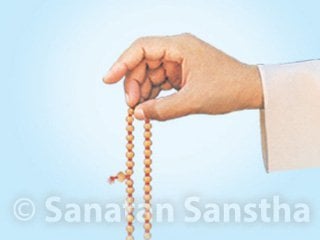 Why do we chant Name of Kuladevi instead of Kuladev?
Why do we chant Name of Kuladevi instead of Kuladev?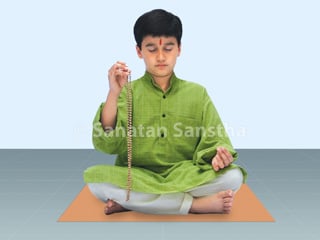 Guidance by His Holiness Bhagwantkumar Menrai on how to coordinate chanting the Name of God...
Guidance by His Holiness Bhagwantkumar Menrai on how to coordinate chanting the Name of God...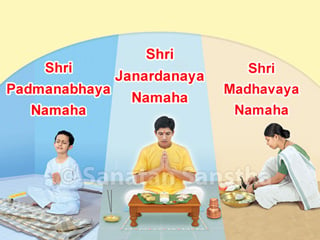 How different chants can help avoid unfavourable incidents ?
How different chants can help avoid unfavourable incidents ? How chanting purifies the mind ?
How chanting purifies the mind ?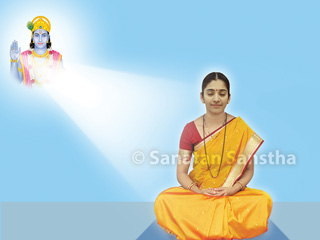 How does chanting help us to achieve oneness with God?
How does chanting help us to achieve oneness with God?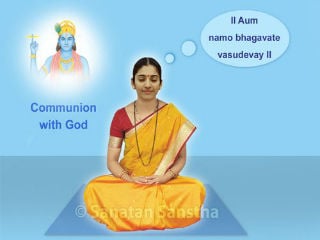 Spiritual benefits of chanting God’s Name
Spiritual benefits of chanting God’s Name